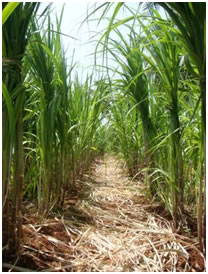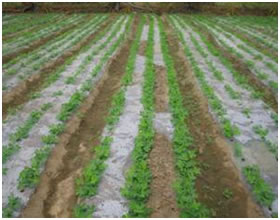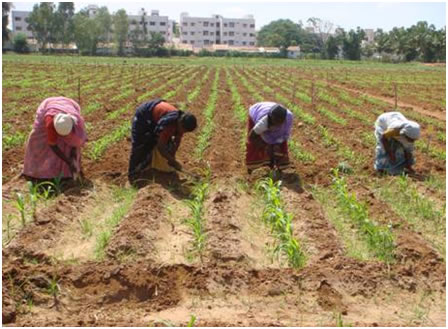DRYLAND TECHNOLOGIES
TECHNIQUES TO REDUCE EVAPORATION AND TRANSPIRATION LOSS
REDUCING EVAPORATION LOSSES
Soil moisture is the most limiting factor in dryland agriculture. It is lost as evaporation from the soil surface and as transpiration from the plant surfaces. Evaporation has to be arrested as it is not directly related to productivity whereas transpiration can be reduced to some extent without affecting productivity of plants. The evaporation losses can be reduced by:
- Mulches
- Antitranspirants
- Wind breaks
- Weed control
Mulches
About 60 to 75 per cent of the rainfall is lost through evaporation. These evaporation losses can be reduced by applying mulches. Mulch is any material applied on the soil surface to check evaporation and improve soil water. Application of mulches results in additional benefits like soil conservation, moderation of temperature, reduction in soil salinity, weed control and improvement of soil structure.
Types of mulches
Soil mulch or dust mulch:
If the surface of the soil is loosened, it acts as a mulch for reducing evaporation. This loose surface soil is called soil mulch or dust mulch. Intercultivation creates soil mulch in a growing crop.
Stubble mulch
Crop residues like wheat straw or cotton stalks etc., are left on the soil surface as a stubble mulch. The advantages of stubble mulch farming are protection of soil from erosion and reduction of evaporation losses.
Straw mulch
If straw is used as mulch, it is called as straw mulch.

Plastic mulch
Plastic materials like polyethylene, polyvinyl chloride are also used as mulching materials.

Vertical mulching
To improve infiltration and storage of rainwater in these soils, vertical mulches are formed. It consists of digging narrow trenches across the slope at intervals and placing the straw or crop residues in these trenches. The pruned plant material is placed in contour trenches formed between rows or in trenches around the plants in concentric circles each year in one circle.
REDUCING TRANSPIRATION LOSSES
Antitranspirants
About 99 per cent of the water absorbed by the plants is lost in transpiration. If transpiration is controlled, it may help in maintenance of favourable water balance.
Antitranspirant is any material applied to transpiring plant surfaces for reducing water loss from the plant. These are of four types:
- Stomatal Closing
- Film forming
- Reflective
- Growth retardant
Stomatal Closing type
Most of the transpiration occurs through the stomata on the leaf surface.
- Fungicides like phenyl mercuric acetate (PMA) and herbicides like atrazine in low concentrations serve as antitranspirants by inducing stomatal closing.
These might reduce the photosynthesis also simultaneously. PMA was found to decrease transpiration to a greater degree than photosynthesis in a number of plants.
Film Forming Type
Plastic and waxy materials which form a thin film on the leaf surface retard the escape of water due to formation of physical barrier.
Mobileaf, hexadeconol, silicone are some of the film forming type of antitranspirants. The success of these chemicals is limited since they also reduce photosynthesis.
- The desirable characteristics of film forming type of antitranspirants are:
- They should form a thin layer,
- They should be more resistant to the passage of water vapour than carbon dioxide and the film should maintain continuity and should not break
Reflectant Type
These are white materials which form a coating on the leaves and increase the leaf reflectance (albedo). By reflecting the radiation, they reduce leaf temperatures and vapour pressure gradient from leaf to atmosphere and thus reduce transpiration.
- Application of 5 per cent kaolin spray reduces transpiration losses.
- A diatomaceous earth product (celite) also increases reflection of solar radiation from crop canopy
Growth Retardant
These chemicals reduce shoot growth and increase root growth and thus enable the plants to resist drought. They may also, induce stomatal closure.
- Cycocel is one such chemical useful for improving water status of the plant
Antitranspirants generally reduce photosynthesis. Therefore, their use is limited to save the crop from death under severe moisture stress. If crop survives, it can utilise the rainfall that is received subsequently. Antitranspirants are also useful for reducing the transplantation shock of nursery plants. They have some practical use in nurseries and horticultural crops.
WIND BREAKS AND SHELTERBELTS
Wind breaks are any structures that obstruct wind flow and reduce wind speed while shelterbelts are rows of trees planted for protection of crops against wind. The direction from which wind is blowing is called windward side and direction to which wind is blowing is called leeward side.
Shelterbelts are planted across the direction of wind. They do not obstruct the wind flow completely. Depending upon their porosity, certain amount of wind passes through the shelterbelts while the rest deflects and crosses over the shelterbelts. It thus reduces wind speed without causing turbulence. The protection offered by the shelterbelts is dependent on the height of central tree row in the shelterbelts. Generally, shelterbelts give protection from desiccating winds to the extent of 5 to 10 times their height on windward side and up to 30 times on leeward side. Due to reduction in wind speed, evaporation losses are reduced and more water is available for plants. The beneficial effect of shelterbelts is seen more clearly in drought years. In addition, shelterbelts reduce wind erosion.
WEED CONTROL
- Promptweed control eliminates the competition of weeds with crops for limited soil moisture.
- Transpiration rate from weeds is more compared to crops.
- Effective weed control in dryland agriculture leads to increasing availability of soil moisture to crops.
This is the most useful measure to reduce transpiration losses.

Spraying nutrient solution
Nutrient solution spray is recommended in the event of revival of rain and release of moisture stress.
- Urea or DAP spray (2% solution) is useful for quicker regeneration of crops like legumes and castor after rain.
|



